How to Grow Onions by Planting & Harvesting Like a Farmer
Author: Jen Worst | Editor: Omar Alonso
Review & Research: Jen Worst & Chris Miller
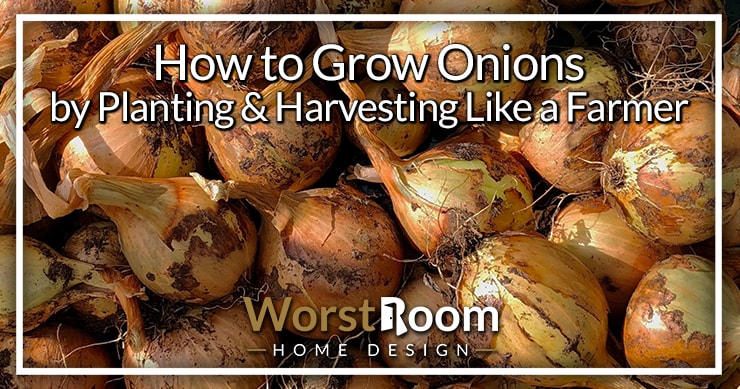
Knowing how to grow onions is simple. It's the person that's willing to stick it out with discipline that gets the big reward come harvest time.
Onions belong to the genus Allium, which is the same genus as garlic, shallots, chives, etc. They're known to have excellent nutritional benefits, taste, and even some other old wives' tales remedy usages.
Apart from anything outside of cooking, onions taste great with nearly any meal. They enhance salads, burgers, sandwiches, pasta, soups, etc. Caramelized onions are a treat, and all the top chefs include them in their recipes.
No wonder everyone wants to grow onions these days! Unlike other vegetables and fruits, planting onions can be done in any free space in your garden or the flower beds present on the corner.
To help you in growing onions in your garden, here is our useful guide that goes through every step from planting them to harvesting them. These types of allium can save you a trip to the grocery store.
How to Grow Onions
Onions are among the oldest cultivated crops. Writings from India, dated as far back as 5,000 years, make mention of onions being grown in gardens in China. We have reference to onions in Egypt in 3,500 BC and other mentions in Sumer from 2,500 BC. That's an old crop!
We're going to go through the process from beginning to end, in order, while providing you with any extra information you need to really maximize your harvest when it's all said and done.
When to Plant Onions
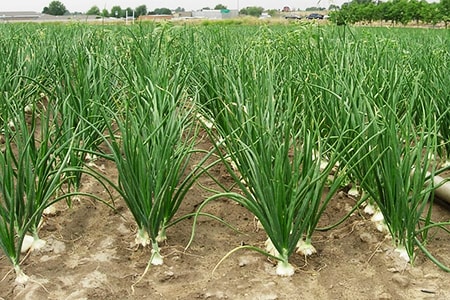
Onions are crops of the cold season, so to get the harvest in fall, they're to be planted in early spring. When you plant onions, make sure that the temperature doesn't go below 28 degrees Fahrenheit. Onions can be planted in cold weather, but it shouldn't be freezing outside.
If you live in a region where winters are extreme, start planting as soon as the ground isn't frozen solid and there won't be another severe frost. This could be from the end of March to April.
If you live in a place where winters are mild, start planting in the late fall or early winter. The onions won't start growing in the cool weather, but once that's passed and the mild spring season starts, they'll grow and thrive coming out of the dormant state.
It's important to plant onions indoors if you are going to use seeds rather than onion bulbs. Plant the seeds almost six weeks before transplanting them in your garden. For proper germination, onions require a temperature of 50 degrees Fahrenheit.
How to Plant Onions
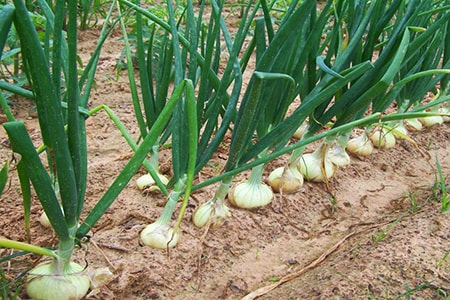
Before you start planting onions on-site, there are a few things you should be careful with.
First of all, onions require a lot of nutrients, and so they must be planted in well-drained, nitrogen-rich, and loose soil. If your soil is depleted, then you can use fertilizer with the proper fertilizer numbers to bring it back into balance.
Before planting, you should also put aged manure and compost in the area you are going to grow in, and do this a few weeks before transplanting your onion bulbs or seedlings.
Plant them in an area that is not shaded with other plants. Onions don't need a ton of hours in the sun, but like all growing things, they definitely need some.
Secondly, onions are not crops that should be planted on the same site every time, year after year. Consider crop rotation with other vegetables. This helps prevent possible diseases and keeps your soil more balanced in terms of nutrient content.
Planting Onions
To make the process convenient, we recommend using small onion bulbs rather than seeds. This is because onion bulbs mature faster in the ground, and it is less work. Avoid using bigger onion bulbs as they may end up seeding too soon.
The faster they mature, the better they can resist diseases and the damage done by pests. You don't want to end up wondering where all these spider mites came from.
For areas that have mild winters, seeds can be used, though. Make sure you're planting your seeds indoors before transplanting them into the garden six weeks later.
Onions should be planted not more than 1 inch deep and should be placed around 4 to 5 inches away from each other.
In rows, the distances should be 4 to 5 inches down the row and 12 to 18 inches between rows. To make sure that the soil keeps its moisture retained, add in some straw mulch. This will reduce the frequency in which you need to water this area of the garden.
How to Take Care of Onions
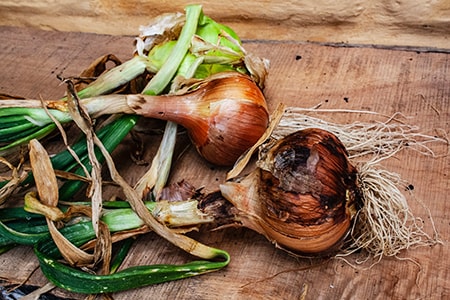
There are three things to keep a check on when doing onion maintenance: water, mulch, and fertilizer.
Water
Onions don't require a complete soaking of water. They only need one inch of water every week, and this includes rainwater as well.
But realize also that you should water the garden daily until the seeds germinate. After germination, you can just water them once every week. If you transplant onion bulbs then start at the once-per-week frequency.
Just make sure that the soil around the plant is moist and not dry. The plants' water needs may increase depending upon the weather conditions of the region you're growing onions in.
If you live in a dry environment, then watering daily is the best thing to do but at a lesser volume so you don't deal with root rot and other problems.
Mulch
If you're adding mulch to your onion garden, then the plants won't require as much or as frequent watering. Using straw mulch traps in moisture. This also saves you time during the weeding process.
Weeds compete with your onions, sucking up nutrients from the soil. So definitely observe your garden every few days and pull up any weeds growing in the rows.
Fertilizer
Until you start seeing bulb formation, you should keep fertilizing your crop with a nitrogen-rich fertilizer. Onions require nitrogen, so using nitrogen-rich fertilizer will give you bigger bulbs.
Use fertilizer rich in nitrogen once every two weeks. That means avoiding 0-20-20 fertilizer and other types that have zero nitrogen in them.
When to Harvest Onions
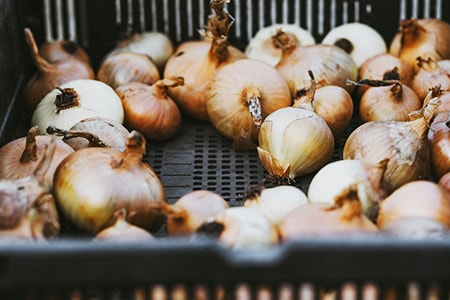
Onions can be harvested after 3 to 4 weeks if you want green onions, but for proper onions you must leave them for 3 to 4 months once you see the green leaves begin flopping on one side and turning brown.
Onion tops, upon maturation, tend to turn yellow at first. Most gardeners and farmers would just bend the tops' heads so that onions can ripen quicker, but I wouldn't do this until you have more experience.
As the tops begin turning brown, you know your onions are ready for harvest. Many people also remove soil from the bulb's surroundings to allow them to dry before pulling them up from the ground. It's not a must.
The harvest usually takes place in late summer or early autumn, as winter may destroy your big onion bulbs. Don't wait too late, even if you planted them late. Smaller and less mature onions are better than none at all.
How to Store Onions
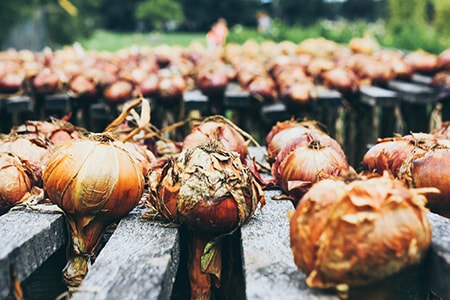
Storing onions is a crucial process that you have to get right if you want them to last. If you want your onions to have some shelf life, then be careful with the process. Yes, I repeated myself because it's important.
Cut out the roots from the mature bulb and clip the tops off to about 1 inch in length. Now leave them in a dry place for curing.
Weather places an essential role in this process. During this time, make sure that the bulbs don't get any bruises, as this may cause rotting. If this drying is occurring during a humid period it may take a little longer.
After letting them dry for some weeks, you can now store them in root cellars. The ideal temperature to store onions is 39 to 50 degrees Fahrenheit. Use nylon or a mesh bag to store your onions. It is okay that they're exposed to the open air in this fashion.
It's recommended not to store onions near pears or apples. This is because these fruits produce ethylene gas, which may disturb the dormant onion state. Onions are also capable of ruining the flavor of potatoes and these fruits, in return. Consider them enemies!
If you have both the sweet and pungent varieties of onion, consume the sweet ones first as they may spoil sooner than the pungent ones.
Diseases Found in Onions
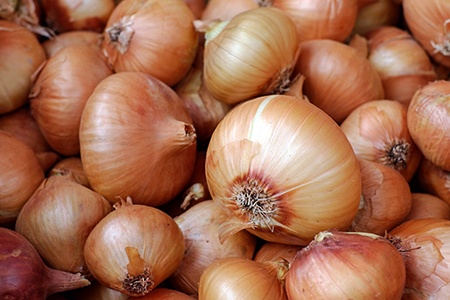
Onion Maggots – This is one of the most common types of problems that gardeners face. Onion maggots are a problem if it rains often. The maggots will lay eggs on and around your plant's base, eating them over time.
To prevent this, you should put netting around your crop and then seal it with soil. You should also season your mulch because pathogens generally grow in the areas where dead materials are present.
This is something to consider if you have maggots in your compost. It's generally not a problem but in cases of late fertilization it's probably a bad idea.
Thrips – These are small insects that may appear in your crop. To know if your crop has thrips or not, take a piece of paper that is dark and then knock onion's top around over the paper.
If thrips are present, you'll be able to see their light bodies in contrast to the dark paper. You can prevent thrips by treating your crop with insecticidal soap spray every three days. Neem oil works as well.
Types of Onions
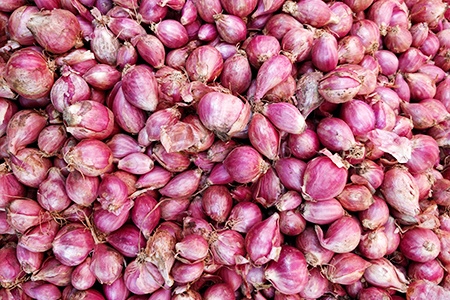
There are many different onion varieties available, and these types of onions are divided into three categories; long-day variety, neutral-day variety, and short-day variety.
Long-day variety – These include first edition, Buffalo, Aisa Craig, Norstar, Walla Walla, yellow sweet Spanish, Copra, and Red Florence onions.
Neutral-day variety – These include Superstar, candy, and red Stockton onions.
Short-day variety – These include Stuttgarter, red burgundy, Southern Belle, and White Bermuda onions.
That's How to Grow Onions
Once you start growing your onion crop, the grocery bought ones will be of no comparison. It may seem challenging to look after your onion crops, but the result is so rewarding.
It's also a great start to gardening. Onions are not the trickiest crop to grow, and you can surely do it with a little guidance and decent research like this article provides.
In this guide, we have covered a lot of details crucial for onion growing, and possible diseases, and their prevention. We hope that you find this helpful and feel happy after your first onion crop harvest. Now you know how to grow onions!



